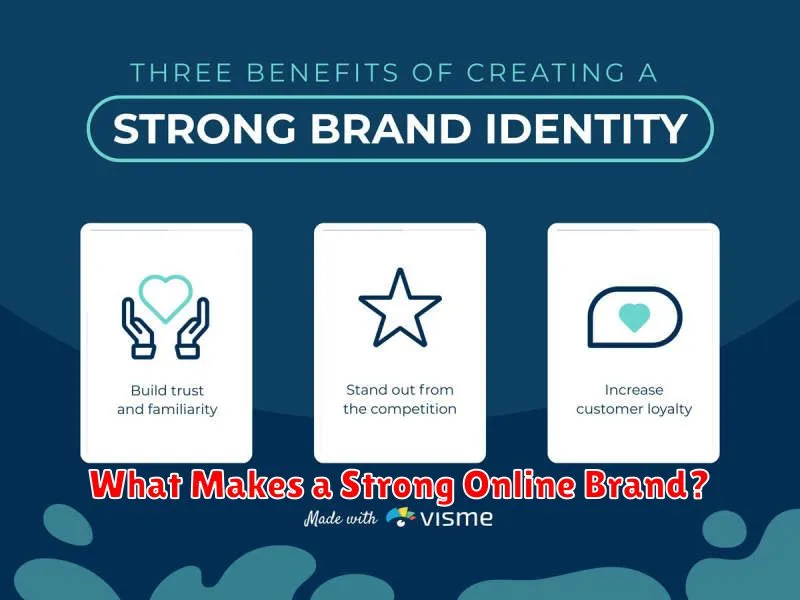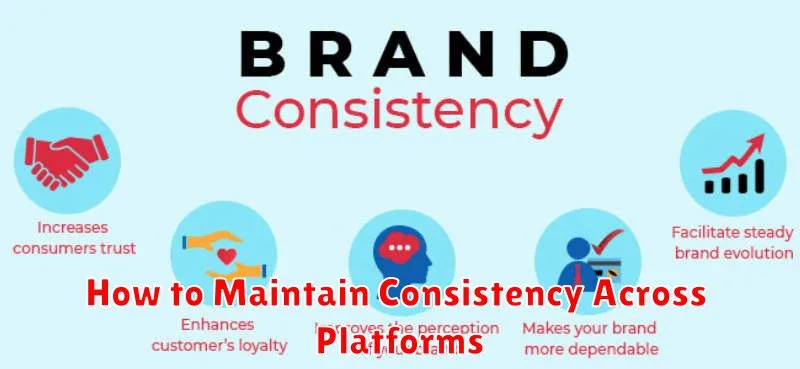In today’s saturated online market, creating a brand that stands out is paramount to success. Building a strong brand identity requires a strategic approach encompassing effective branding, compelling online presence, and consistent brand messaging. This article will explore key strategies to help you develop a unique brand that resonates with your target audience, drives brand awareness, and ultimately establishes your business as a market leader in the competitive digital landscape. Learn how to leverage digital marketing techniques to build brand loyalty and achieve sustainable business growth.
What Makes a Strong Online Brand?

A strong online brand is more than just a logo and a website; it’s a carefully cultivated perception in the minds of your target audience. Several key elements contribute to this strength.
First, a clear brand identity is crucial. This involves defining your brand values, mission, and unique selling proposition (USP). What makes you different? What problem do you solve? This clarity guides all your online efforts.
Second, consistent branding elements across all platforms are essential. This includes your logo, color palette, typography, and messaging. Maintaining consistency reinforces brand recognition and trust.
Third, engagement is paramount. Actively interacting with your audience through social media, email marketing, and other channels builds relationships and fosters loyalty. Responding to comments and feedback shows you value your customers.
Finally, a strong online presence requires a well-designed and user-friendly website. It should be easy to navigate, visually appealing, and optimized for search engines (SEO). A positive online experience is vital for brand building.
In short, a strong online brand is built on a foundation of clarity, consistency, engagement, and a positive online experience. These elements work together to create a memorable and impactful brand that resonates with your target audience.
Defining Your Brand Voice and Personality
Your brand voice is the tone and style of your communication. Is it formal or informal? Humorous or serious? Consider your target audience and your brand’s overall message when defining this crucial element. Consistency is key; maintaining a unified voice across all platforms builds brand recognition and trust.
Your brand personality is the human-like characteristics you assign to your brand. Is it friendly and approachable? Sophisticated and elegant? Bold and innovative? A well-defined personality helps you connect with your audience on an emotional level. It should align with your brand values and resonate with your target demographic.
Defining both voice and personality is essential for creating a memorable and impactful online presence. A strong brand identity differentiates you from competitors and fosters customer loyalty. By carefully crafting these elements, you build a brand that not only stands out but also effectively communicates your unique value proposition.
Choosing Colors, Typography, and Visual Elements
Color selection is crucial for brand recognition. Choose colors that reflect your brand’s personality and resonate with your target audience. Consider using a limited palette for consistency and impact. Research color psychology to understand the connotations associated with different hues.
Typography plays a significant role in brand readability and aesthetic appeal. Select fonts that are legible and reflect your brand’s voice. Consider using a combination of fonts—one for headings and another for body text—for visual hierarchy and improved readability. Maintain consistency in font usage throughout all brand materials.
Visual elements, such as logos, icons, and imagery, contribute significantly to brand identity. Ensure that all visual elements are cohesive and consistent with your brand’s overall aesthetic. High-quality visuals are essential for projecting professionalism and credibility. Consider using consistent imagery styles (e.g., photography, illustration) to create a unified look.
Crafting a Memorable Tagline and Mission Statement
In the crowded online marketplace, a strong brand identity is paramount. This begins with crafting a memorable tagline and a clear mission statement. These two elements work in tandem to define your brand’s essence and communicate its value proposition to your target audience.
Your tagline should be concise, impactful, and memorable – ideally, something that sticks with potential customers long after they’ve encountered your brand. It should encapsulate the core benefit or unique selling proposition of your product or service. Think short, catchy, and easily repeatable.
The mission statement, on the other hand, provides a broader overview of your brand’s purpose and values. It articulates your long-term goals and explains why your company exists. It should guide your decision-making and inspire both your team and your customers. While a tagline is short and punchy, a mission statement is more detailed and aspirational.
When crafting both, consider your target audience. What resonates with them? What are their needs and desires? Aligning your tagline and mission statement with your audience’s preferences ensures maximum impact and brand recognition.
Ultimately, a well-crafted tagline and mission statement are fundamental to creating a coherent brand identity that resonates with your audience and sets you apart in the competitive online landscape. They serve as the foundation upon which your entire marketing strategy is built.
How to Maintain Consistency Across Platforms

Maintaining brand consistency across multiple online platforms is crucial for building a strong brand identity and maximizing your impact. Inconsistency can confuse your audience and dilute your message. To achieve this, establish a clear brand style guide. This document should outline your brand’s voice, tone, visual identity (logo, colors, fonts), and messaging. This serves as a central reference point for all your online activities.
Use the same logo and color palette across all platforms – your website, social media profiles, email marketing, etc. Maintain a consistent brand voice; whether it’s formal, informal, humorous, or serious, keep it consistent. Ensure your messaging remains aligned with your overall brand values and objectives regardless of the platform.
Employ a centralized content calendar to manage and schedule posts and updates across platforms. This ensures a coordinated approach, preventing inconsistencies in timing or messaging. Utilize brand-approved templates for social media posts, emails, and other content to maintain a unified visual style. Regularly review and update your brand guidelines to ensure they remain current and relevant.
Finally, monitor your brand presence across platforms. Track how your brand is perceived and address any inconsistencies promptly. This proactive approach ensures your brand message remains clear, strong, and memorable in the minds of your audience.
Using Storytelling to Connect with Customers
In the crowded online marketplace, a compelling brand narrative is crucial for standing out. Storytelling transcends mere product descriptions; it fosters an emotional connection with your audience.
By sharing your brand’s origin story, you reveal your values and build trust. Highlighting customer success stories showcases the impact of your product or service. Authentic narratives resonate deeply, creating loyalty and advocacy.
Consider incorporating personal anecdotes, highlighting the challenges you overcame and the journey you undertook. This humanizes your brand and makes it more relatable. Remember to focus on the emotional arc of your story, allowing customers to empathize and connect on a personal level.
Effectively using storytelling requires understanding your target audience. Tailor your narratives to resonate with their values and aspirations, building a community around shared experiences and beliefs. This will cultivate lasting relationships and brand loyalty, ultimately setting your brand apart from the competition.
How to Handle Brand Reputation Online
Monitoring your brand’s online presence is crucial. Utilize tools to track mentions across social media, review sites, and forums. This allows for proactive issue identification.
Responding to both positive and negative feedback is essential. Address concerns promptly and professionally. A quick, empathetic response can significantly mitigate negative impacts. For positive feedback, express gratitude and engagement.
Engaging with your audience directly fosters a sense of trust and transparency. Actively participate in relevant online conversations, answer questions, and address concerns publicly. This demonstrates accountability and builds relationships.
Managing negative reviews requires a delicate approach. Don’t delete critical reviews; instead, address the concerns directly and professionally, offering solutions whenever possible. This demonstrates your commitment to customer satisfaction.
Proactive reputation management involves consistently producing high-quality content and providing excellent customer service. A strong brand reputation is built on providing value and positive experiences. This forms a solid foundation against negative feedback.
Building Brand Loyalty Through Customer Experience
In the competitive online market, customer experience is paramount for building brand loyalty. A positive experience fosters trust and encourages repeat business.
Exceptional customer service is key. This includes prompt responses to inquiries, efficient problem-solving, and personalized interactions. Proactive communication, such as follow-up emails or helpful tips, further strengthens the relationship.
Understanding customer needs is crucial. Collecting feedback through surveys and reviews allows businesses to identify areas for improvement and tailor their offerings to better meet customer expectations. Analyzing this data provides valuable insights for enhancing the overall experience.
Building a strong online community also contributes to loyalty. Engaging with customers on social media platforms, fostering a sense of belonging, and creating opportunities for interaction builds a deeper connection with the brand.
Ultimately, prioritizing customer experience translates to increased brand loyalty, leading to sustained growth and success in the online marketplace.

